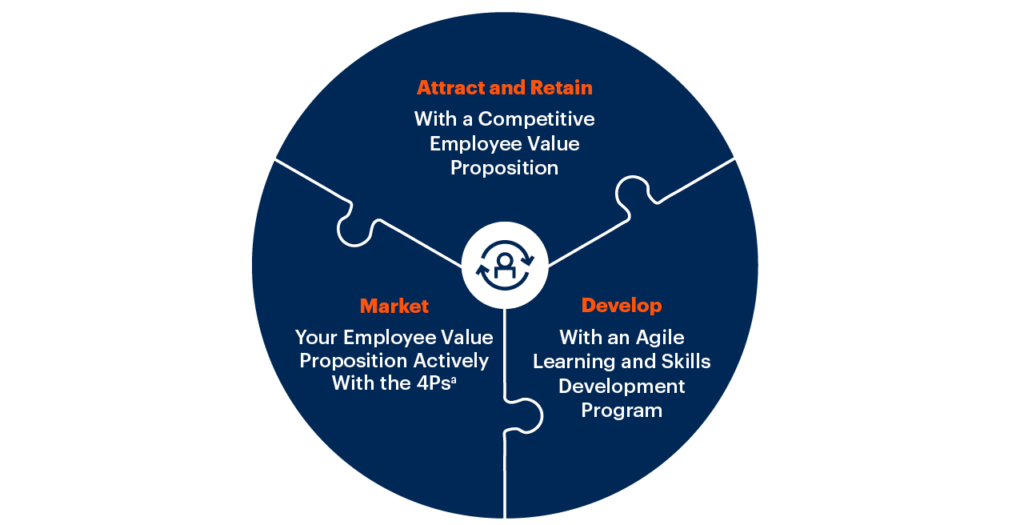These days, digital disruptions happen all the time. They have only surged lately with COVID-19, and it’s essential to know how these technologies are linked to your business – be it for efficiency reasons or for capitalising on the latest marketing trends. Digital transformation is a must for companies looking to stay competitive in today’s market. It will require the whole team to work together and a consistent level of commitment from the CEO as well. This means focusing on initiatives that can scale throughout the organisation, working to establish minimally viable milestones and gently measuring their impact.
A CEO might think that a functional leader should be in charge of monitoring and driving digital metrics. Of course, some business-level metrics should be recorded by functional leaders as well. For instance, tracking the share of sales revenue is the job of the head of sales. But a digital transition spans the entire organisation, not a single department. A CEO is therefore uniquely positioned to have a full view and influence of every aspect of the business. This allows them to ensure that the entire organisation is leveraging digital dollars. The following metrics are an excellent way to measure company success. These cross-organisational metrics show how far the company has come and give the CEOs insight into their efforts.
Five metrics to consider by the CEO
Once you’ve implemented your prioritised digital road map, measuring performance is essential to ensure that all the investment is worth it. It’s important not to forget any details, or else the entire project could come down. To make sure that your company is progressing correctly, CEOs should make sure to monitor five significant markers.
1. Linking business leaders’ incentives to the value-creating digital builds

A CEO needs to make sure that all leaders in the organisation are on board with digital transformation and are driving real value. Aligning incentives is vital for achieving these aims. This includes linking digital incentives among these leadership positions, including the head of technology. Organisations that are serious about digital know that they need more than one technology leader. There’s the chief digital officer and the CIO, for example. However, CTOs are in charge of effectively deploying technology to support business objectives.
For some organisations, this may mean they will have to rethink what a CTO should do. Some, particularly in digitally native companies, have the responsibility to oversee all aspects of the product. This includes from design right through to delivery and managing all technology development decisions. In many cases, the incentive bonus is now linked to tasks such as developing new features and shorter cycle times which makes it easier to set priorities.
Also read: 7 Reasons To Switch To Cloud Analytics For Better Marketing
CTOs in long-established companies are typically more involved with infrastructure, security and operations. They also take on some of the responsibilities for overseeing in-house application development and aspects such as subject matter expertise. A downside of this structure is that it encourages an attitude of risk avoidance which results in sluggish business values that drag on timelines. Leading in the age of technology disruption requires more than just a CTO mindset. A CEO’s job is to motivate and incentivise better, to empower and align a CTO’s incentives with a “builder” mindset. Shifting to the perspective of value production will have a significant impact on your team’s culture.
2. A CEO should measure the return on digital investments

Measuring the ROI of your digital marketing initiatives is both crucial and standard. CEOs should measure their individual projects’ value as well as the collective support they provide to company-wide goals. It’s worth remembering that there’s no such thing as standing still when your competitors are moving forwards. If you don’t invest in digital change, then you will be at a disadvantage and end up with dwindling consumers. Make sure to keep up with the latest technologies.
Also recommended: Metrics That Matter to CMO
Work on one business domain at a time, and expand from there when you’ve established some initial traction. The domain is a critical process, customer journey, or function. For example, a marketing domain for a consumer goods company might include customer acquisition, pricing and retention.
Organisations can avoid the strain on resources and ensure higher quality by focusing their efforts on one area at a time. That way, they can continue to use data sets and technology for multiple different use cases without having to spend time retooling or going back to the drawing board each time. A retailer could greatly benefit from adopting the same geospatial data for the customer-experience domain in-store, allowing them to optimise store footprints and prioritise capital expenditures. They can also personalise their assortment of local items per customer needs. Allowing different use cases to work together can enable a cross-functional team of professionals to deliver much more value than just one use case. This helps your business grow in many fields.
What else?
You can also maximise ROI by directing enough resources towards adopting new digital tools. A predictive insight is only valuable if the actions it enables are taken into consideration. For example, customer data could show two different groups of customers who seem to be buying elsewhere. Just by identifying this problem, marketing or sales associate could take steps to make sure these customers are happy with a company. Also, to ensure the change is actually adopted, the company should put in place some change-management initiatives that encourage adoption. One study found that companies that were successful at scaling their analytics initiatives were twice as likely to do so by getting buy-in from the top leadership. They also invested twice as much of their analytics budgets in adoption and change management than other companies [1]
3. Amount of yearly budget spent on innovative digital initiatives

Driven by the increasing importance of digital communication and piqued interest by consumers, many organisations are devoting a small proportion of their budgets to digital-enabling their more comprehensive business strategy, with the hope that this will maximise return on investment. Organisations must allocate a sizeable percentage of their budget towards new technology, as CEOs see it as key to delivering business value. Organisations are well-positioned to streamline service delivery and cut costs when armed with the latest machinery and gadgets.
Suppose you have been using monolithic IT architecture. In that case, it’s time to consider alternatives like microservices and custom application development. These things will revolutionise your work by giving your teams the flexibility to be creative and build products that fit your needs.
One reason that some companies spend so much money on maintaining and protecting their IT infrastructures is because of the complexity and out-of-date systems they have. These can be as old as 15 to 20 years or even more, which might make them very hard to upgrade or fix. Many companies are beginning to realise that replacing their systems may not be the best choice. Instead, teams should try simplifying and renewing the systems that provide the most significant business value by dividing their technology platform into a set of microservices and accelerating its ability to develop new apps faster.
Conventional companies might find themselves less flexible than digital attackers. Still, these companies can be formidable opponents in the digital age by continuing to improve their other strengths and build on them.
4. Attract, promote and retain top tech talent

The ability to attract and retain top tech talent is arguably the most important way to succeed in the digital age. It’s likely you’ll need to amend your talent strategy as you progress through your digital transformation.
How to achieve it
- Getting started. In the early stages, organisations will want to focus more on having enough senior architects and professionals. As you gain momentum in your digital transformation, you should build out a team of technical specialists and people who ensure the quality of the products. If a business wants to be successful, it is vital that the CEO understands the organisation’s needs and has a way of measuring progress. This will help them ensure that there is always fresh talent who shares their drive for constant growth.
- Creating a balance of tech and general talent. Work towards creating a balance between tech talent and all-around talent by seamlessly integrating them into the company culture. One way to measure your company’s transformation is through the percentage of ‘tech talent’ performing the work rather than those in a management position. This number typically starts low and steadily increases towards 70% over time.
- Ensure retention. It’s important that CEOs make sure employees in their company are happy. One way they can do this is by paying attention to certain aspects of their employees’ lives. For example, companies want to know if the rate at which digital talent participates in technical communities is greater than or equal to the career progression rate within the company.
- Talent integration. One of the best ways to scale your business and take advantage of digital opportunities is talent integration. If you keep a silo of technical talent that doesn’t work closely with the general employees, it will be more challenging to succeed in the digital realm.
- Upskilling existing talent. One of the most effective ways to improve your digital talent is by figuring out how well you’re training the current people on your team. Looking at factors like quality and accessibility of training can tell you a lot about this.
5. Taking note of the time needed to build a digital application

Speed matters. In a digital environment, translating ideas into tools that can be used on the front line is essential. If you want to stay competitive, delaying the production of these kinds of products or rendering them obsolete by the time they’re out is not an option. You have to move fast.
Rapid technology development is just as important as the quality, but with the same level of urgency. Products need to provide a quality customer experience from the beginning. This means that organisations need to integrate DevOps and quality assurance into the development process to make any necessary improvements at a nascent stage. Any relevant changes should be implemented over time after the product is released to customers.
Also read: An Easy Guide To Create, Measure And Evaluate Your Facebook Social Media Campaigns
Ultimately, the responsibility for tracking this metric lies with the team developing a digital tool and the organisation’s technical leader. The CEO has to be on top of all major tasks and deadlines, as well as involve technical leadership. It’s their responsibility to examine the digital initiatives across the whole company, checking if they are meeting deadlines or going over them. Agencies that take the time to institutionalise best practices are better poised for digital success in the long term. This typically involves establishing clear timelines and implementing best-practice approaches.
It is also vital to prioritise measuring the cycle time from release-to-use, not release-to-proof. CEOs need access to data which depicts how long it takes for company applications to be actually used by customers. It’s wise also to measure and calculate the percentage of applications that are utilised after being released.
Deployment speed is undoubtedly the most important key performance indicator in digital and analytics. It reflects how well you can extract insights from data and determines how quickly they can be implemented.
Conclusion
When CEOs understand the metrics that matter, they can tell whether digital investments are paying off. All functional leaders should measure these metrics within their domains of responsibility, but only the CEO has the organisational perspective and mandate to create holistic value through digital by delving deeply into all parts of a business.
Endnotes
- https://www.mckinsey.com/capabilites/quantumblack/our-insights/breaking-away-the-secrets-to-scaling-analytics















